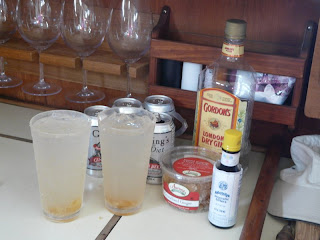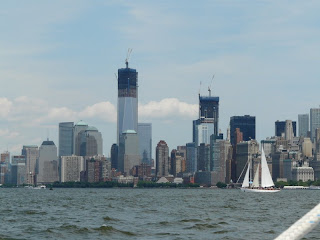We’re on our way to Block Island. We’ve really been on our
way to Block Island for some time now. Located halfway between Montauk and Cape
Cod, Block is the jumping off point for the northern waters. The question has
never been, “where are we going?’ but instead, “How are we getting there?”
We could have gone straight up and across from Cape May,
making a thirty-six hour off-shore passage and arriving nice and early in our
trip, skipping all of those other stops. Since we weren’t sure how I would
handle the ocean waves and swell, this was pretty much a non-starter. Another
possibility would have been a shorter hop, an overnight from Barnegat, skipping
Manhattan and going directly to Block in the waters south of Long Island. The
weather would have been good for such a trek, but unfortunately Rick didn’t
think of it until we were headed into Sandy Hook and by then it was pretty late
in the day to change our minds. I think the memory of my seasickness episode
the other day probably kept the possibility of an overnight, off-shore journey,
even a modest one, strongly out of his mind. But neither one of us is looking
forward to a repeat of last year’s fly-infested, stagnant-air run down the Long
Island Sound. Unfortunately, it looks like we are left with no other choice.
Once leaving Manhasset, we will need to make three or four stops before we can
shoot through the Race and land on Block Island.

The wind is pretty nonexistent this morning, so we’ll have
to motor until later in the day. Leaving Manhasset, we pass a giant mansion out
at the end of a point. Isn’t this the mansion portrayed as Katherine Hepburn’s
family house in “The Aviator”? Rick has heard that the Hepburns had a house
around here and we start calling this one “Kate’s Place”. It’s
pretty big and it takes us a while to get out of sight of it.

There is obviously big money in this part of the Long Island
Sound. The houses that line the shores probably should be summer cottages, but
they are gargantuan, even for houses to live in year round. At the end of the
afternoon Rick pulls us in to Huntington Harbor, where he knows we’re not
allowed to anchor but he likes the feel of this little upscale town and wants
to look around. The narrow harbor winds around quite a bit, and the shores on
both sides have a pleasingly diverse topography. Mansions or not, it is quite
picturesque. Rick has a particular favorite building – an abandoned, churchlike
structure that he thinks is the nicest house in the neighborhood. I think it
looks like a smaller version of the Hagia Sophia in Istanbul, and even though
I think it’s a cool building I’m not sure I’d want to live in it.
There is a boat in the marina that appears to be sinking
right on its mooring! They have it all roped off, so obviously we are not the
first to notice.

We head out of Huntington and over to nearby Lloyd’s Harbor to
find a place to put down our anchor. There are a few different ways to park
your boat. The most protected and also the most expensive thing to do is to
rent a slip at some marina. Rick has a slip for Valkyrie in Baltimore and he
rents that slip on a yearly basis, but when you are cruising, taking a slip is
usually prohibitively expensive. Some places will let you dock, but that is
usually reserved for very temporary stays of a few minutes to refuel, or to
load or unload. If you want to spend the night you usually have two options –
take a mooring, or set your own anchor. Anchoring can be a tricky business. You
have to be sure that there will be enough water for your boat when the tide is
low, you have to know how much anchor chain (rode) to let out in different
weather conditions, you need different types of anchors for different types of
sea bottoms (mud, weeds, rocks, etc.), and you can never be absolutely sure
that your anchor will hold in a storm or heavy wind. Moorings on the other hand
are great because you can just tie up your boat and forget about it - go
ashore, leave it for a week, whatever - you know it’s not going anywhere. So
why anchor, you ask? Well, quite simply, anchoring is free.
Moorings can be relatively reasonable - $25 a night – or
they can cost a lot - $3-4 per foot of boat per night. Three dollars a foot for
Valkyrie would be a hundred and five dollars. Sometimes they are free as well
and we take advantage of them when they are available, and when weather conditions
call for it we think it’s money well spent. But most of the time we’re just too
cheap to pay for a mooring ball and we anchor instead.

When we leave Huntington Harbor, we figure we’re leaving the
hoity-toity neighborhood to park in a more welcoming area down the street. Of
course anchoring in Huntington was never a question, but upon entering Lloyd’s,
we’re slightly chagrined to learn from a prominent sign that we are relegated
to a very limited area designated for “transients”. I don’t think I’ve ever
been called a “transient” before. We swim naked and then hang out our laundry
to dry just to fulfill the transient image, then have a drink and watch the
sailboat race that seems to be happening right in our front yard.


Our close friend Marguerite Thomas came up with a
sea-sickness cure for me, so when we were in Manhasset we just had to buy the
ingredients and now we get to try it out. It’s a drink featuring plenty of
ginger, the legendary seasickness cure: candied ginger, gin, bitters and ginger
beer. A “Gin-gin”! (You can read about
it at Wine Review Online ) I’m not sure if
it does anything for my mal de mer,
but it does make a great drink. Tchin-Tchin!
Rick connects the interior speakers on Walter’s unfinished
stereo system and then plays “The Ride of the Valkyries” at full indoor and
outdoor volume, blasting out the other boats. I know it’s corny, playing music
that matches the name of our boat, but what a thrill it is to hear that amazing
music with waves at your feet and wind in your hair! We follow up with Mahler
One.
“Transients” FOREVER!
The next morning the forecast for wind is not good for
sailing, and it remains bad for some days. So far we have miraculously been
spared any visits from those nasty flies, but with light air from behind us we
know they are overdue. Rick thinks if we can get ourselves over to the
Connecticut side of the Sound we will be at a better angle for sailing in
these wind conditions tomorrow. We decide to head over to the Thimble Islands. The
Thimbles are a truly unique set of closely spaced little islands, little haystacks of rocks that really look like thimbles, just off the
coast of Connecticut near New Haven. Many of these tiny islands sport only one
house, precariously built on stilts over the lava rock surface. Some of them
have a few houses crowded in together. I remember being completely charmed by
them last year and am really happy to be spending the night here again.


In the morning we head out once again, this time for Coecles
Harbor. Rick is delighted because even in the relatively light air, Valkyrie
sails beautifully. The old Alberg would have been a wet snail. We are followed
for quite a ways by a boat with a spinnaker. These are the colorful
balloon-shaped sails that you sometimes see; they are great in light air that
is coming from directly behind you. We would probably have used one a few times
on this trip, but unfortunately, Valkyrie doesn’t have a spinnaker. This is one
of the things Rick would like to change in the coming years, but at least for
this summer, we will have to do without one.

As we are turning into Plum Gut (love the name), a giant sea turtle appears right at the stern of
the boat! His shell is probably about four feet in diameter, spotted with great
clusters of white barnacles, and his head and neck stretch out another foot and
a half, his mouth open and gasping for air. Rick quickly turns the boat around
to go back and get a longer look, but our friend Mr. Turtle has already left
the surface. Apparently a fellow transient.

Coecles Harbor (no idea how you pronounce this thing) is a
sweet little place; basically a small, almost fully enclosed lagoon. There are few
cottages in the immediate vicinity, but many boats have come in to anchor. A
swim is absolutely in order after the hot day. We get seemingly little exercise
on board, so I began our trip with the promise to myself that every time we
went for a swim I would do five laps around the boat. It’s never boring because
you usually have some kind of current to work against, at least in one
direction. Also, Rick never seems to get bored by chasing after me for a goosing. Today I go for six laps!

We fire up the charcoal grill that is attached to one of
the side rails in preparation for the two obscenly enormous steaks we bought
in Manhasset. Four pounds of meat is obviously too much food for the two of us
(maybe I should have done twenty laps), but the intention is that we will have
leftovers, saving cooking time on another night. After doctoring them up with
an herb rub, “the critters” are sizzling on the grill and Rick comes below to
tease me about something-or-other, when we hear seagulls whooping it up
outside. When we rush back out to see what’s going on, one of the steaks is
missing. GONE. We keep looking at the grill in disbelief – surely the steak
will reappear. The seagulls have swarmed around our boat, calling to one
another and raising quite a ruckus, but none of them seem to have the steak
either. We would absolutely know what happened if we had seen one of the gulls
flying off with our meal, but probably that steak was too heavy (and hot!) for
the thief and it is now sinking to the bottom beside our boat. We quickly get
out the grill cover before they can grab the remaining steak, and two of the
more aggressive gulls get in a real set-to with one another, right there in the
water. “It’s YOUR fault!” “No, it’s YOURS!” It’s a good thing seagulls can’t
seem to work together or we would have lost everything.
As it turns out, two pounds of steak is more than enough for
two, or even three meals. Perhaps we got what we deserved for our gluttony. Anyway,
I’m sure the crabs will have a great time with our steak.
The Patron Saint of Human Torments must be smiling down on us because we have
had no flies over the entire trip out Long Island Sound. Now poised just at the end of
the Sound, we have one more short day of travel before we can get to Block
Island. Our decision to stay in Coecles has put us just south of the Race so we
will miss out on that wild ride, but it was fun to visit a new place so I'm not sorry. In the
morning we up anchor and head out once again. I kind of like being a transient.



















































